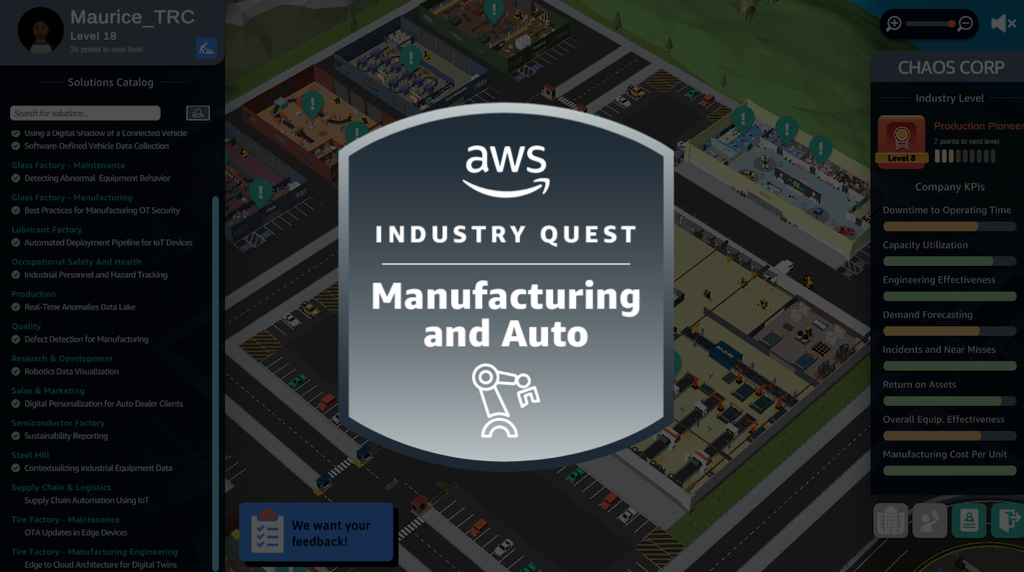I currently have some time on my hands and decided to dive deeper into the AWS Skill Builder. Originally, I was interested in learning about Timestream for a training that I delivered, and then I stumbled upon the AWS Industry Quests. I remember not being very interested when they launched a while ago, but since they’re included in my subscription, I decided to give it a chance.
Because my initial search for Timestream led me to it, I started the Industry Quest for Manufacturing and Automotive. Initially, I was asked to create a company name and a character, and since I didn’t care too much, I just went with a random character, although there are many customization options. Once you’ve completed the initial setup, you’re dropped into your industrial area and a tutorial that guides you through the initial steps.
To become a Titan of Industry, you have to solve problems in your manufacturing plant with the help of AWS services. Doing that improves your company’s and your own KPIs and level. Additionally, you collect Gems, which allow you to upgrade parts of your factory.
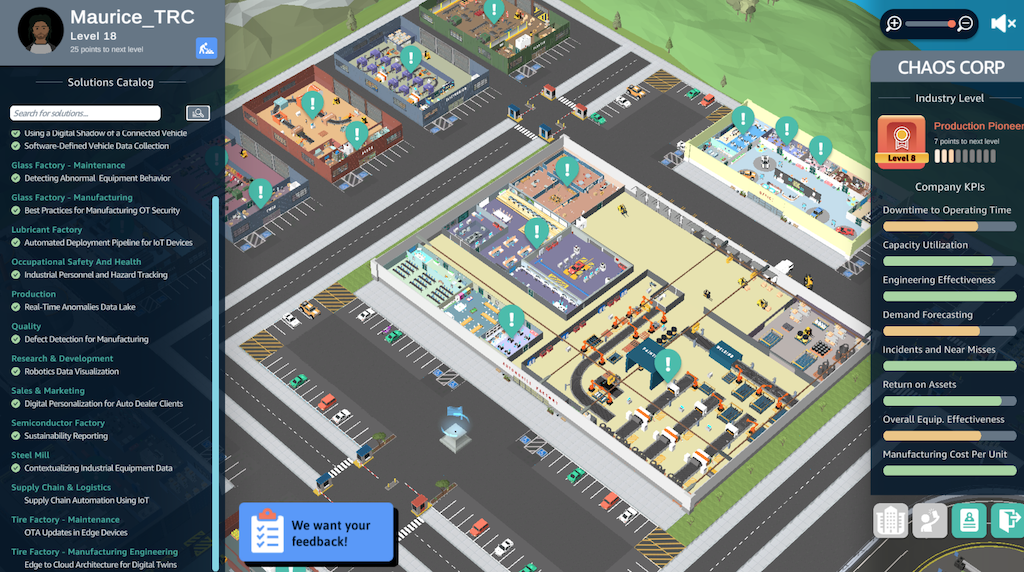
At the time of writing, the Industry Quest: Manufacturing and Auto has 18 problems to solve, i.e., 18 labs to complete. Each Lab introduces a business context and provides an overview of the AWS services you’ll be interacting with.
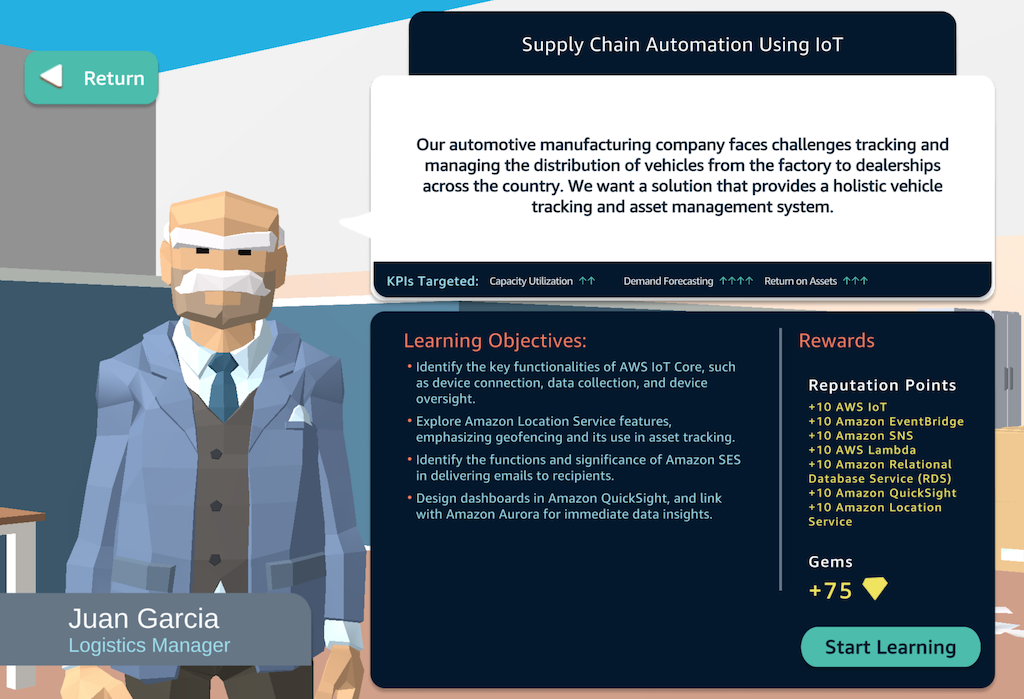
When you start the task, you get an overview of the solution architecture, including links and additional videos explaining the services and concepts involved. This allows you to familiarize yourself with the building blocks that you’ll interact with.
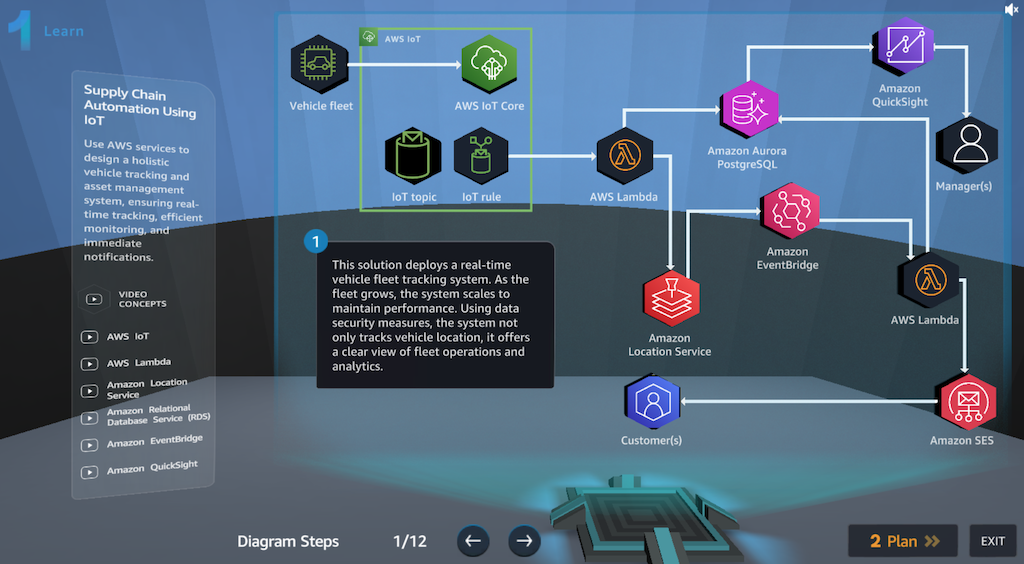
Next, the environment introduces you to the two interactive parts of the experience. A guided practice phase in which you get step-by-step instructions to build up parts of the infrastructure (you don’t start from scratch) and a later DIY phase in which you have to do some things on your own.
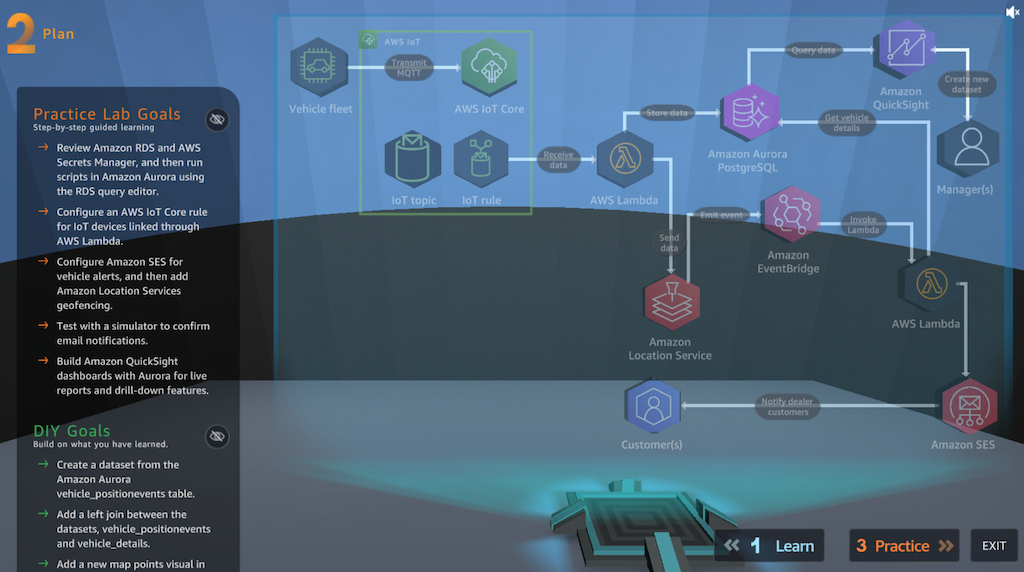
In the practice phase, you first launch the lab environment, which may take a few minutes, depending on the Lab. You get a fresh AWS account for each Lab that’s available for a couple of hours. Once that’s provisioned, you log in and go through the instructions. They’re usually quite accurate, although sometimes the UI screenshots are slightly out of date. I experienced some problems here, but more on that later.
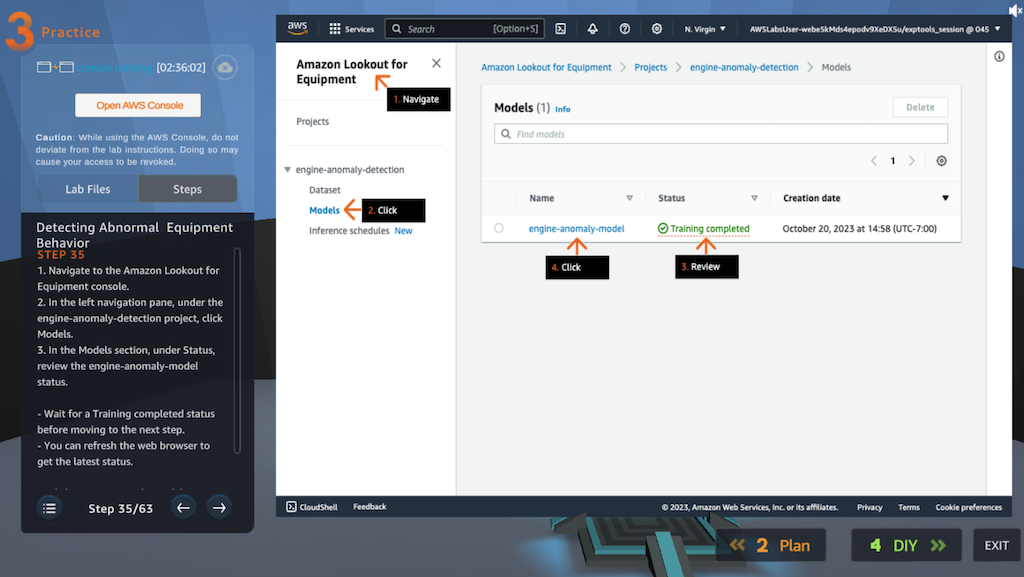
It’s a bit frustrating that you can only switch between the steps using the two arrow buttons. That means if you’re at step 50 and notice that something is not working as expected and you want to double-check instruction 15, you get to click the back button 35 times (you can also enable a scrolling feature, but that was very buggy in the browsers I tried it in. The second annoyance I experienced here was that when you switch between browser windows or tabs, it always takes two clicks for the first button press to register, but you’ll get used to that after a while.
Once you have completed the practice section there’s a DIY part in which you’re asked to complete one or more tasks on your own. These are usually not too difficult to complete and I found them useful because they forced me to think about the problem myself. If you’re struggeling, there are also some hints that can help you solve the tasks.
It also has a built-in validation system to check if you’ve actually solved the tasks. Each DIY section explains its “scoring” method, and you get decent feedback for partially correct solutions.
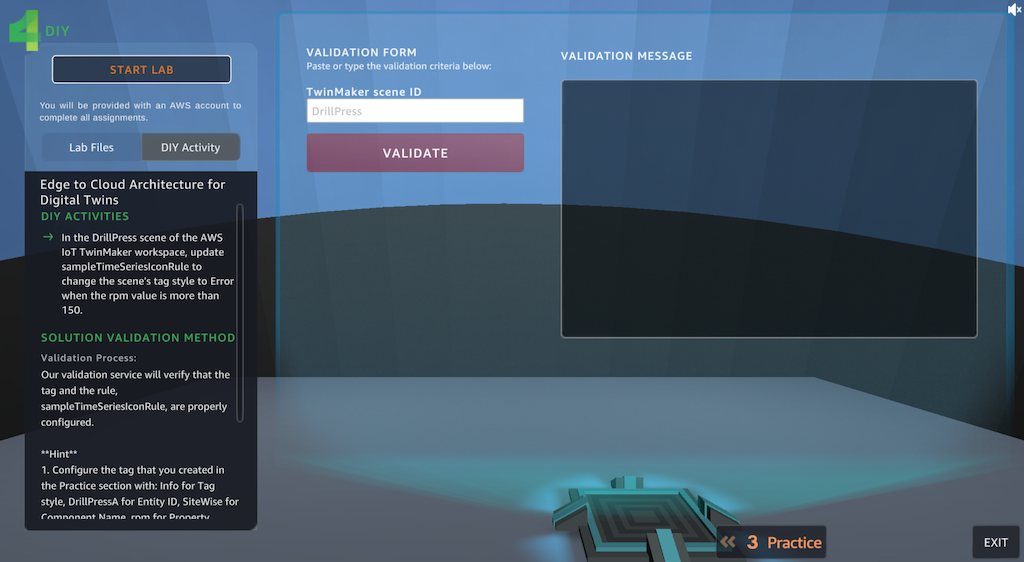
For each completed Lab, you get some experience points and gems that help you expand and improve your factory. To me, it seems like another attempt at gamification because games are supposed to have in-game currencies and levels, but I don’t really see the point. At least it doesn’t hurt, although, about midway through the game, I stopped being able to spend my gems on anything; I’m not sure if that was a bug or the new customizations were just not available.
While these game mechanisms are part of the fun, they’re not the focus of the experience. The goal is to learn about building solutions for manufacturing and automotive in AWS, primarily achieved through the labs or tasks you solve. This is where the industry quest shines.
I’m probably not the intended target audience here, because I’ve been working with AWS for 5+ years but mostly in the serverless and data spaces, which means I have a decent amount of pre-existing knowledge that may bias how I feel about the labs.
Most of the labs focus on IoT use cases and the vast majority of the tasks start out with configuring some things in IoT core or Greengrass. You learn a lot about provisioning and updating (custom) components and software on IoT devices, which I imagine is very useful to people working in that industry.
Once your things are connected to IoT core, the labs teach you what you can do with all that data. You explore machine learning services for anomaly detection and predictive maintenance. You build solutions for real-time monitoring and alerting based on Timestream and Grafana. You build fancy dashboards in Grafana that visualize machine operations using AWS TwinMaker and so much more.
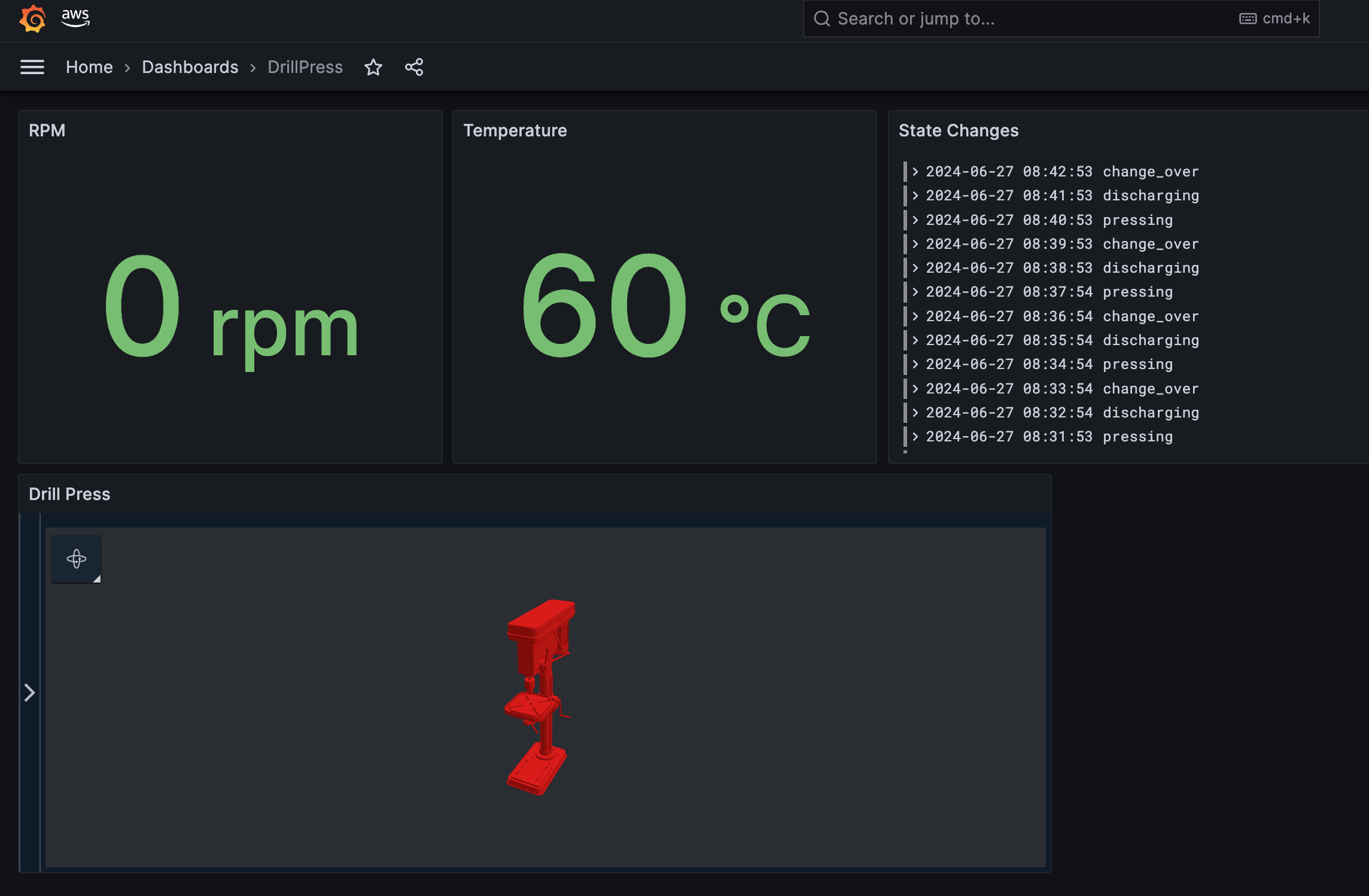
Aside from these metrics and monitoring you also build reporting solutions using quicksight, which teaches you how to make management happy. Moreover you learn how to handle location data and track people through hazardous areas while visualizing and alerting when they enter dangerous parts of the factory using the Amazon Location service.
One of my favorite labs is called “Using a Digital Shadow of a Connected Vehicle”, which teaches you how you can use the IoT Device Shadows to build an app that allows you to control the state of headlights, doors, and other car components from a nice webapp. While none of the graphics here are on the level of AAA games, it’s always fun to see virtual doors open when you click a checkbox, especially when the underlying synchronization mechanism could be used to have the same effect on your physical car.
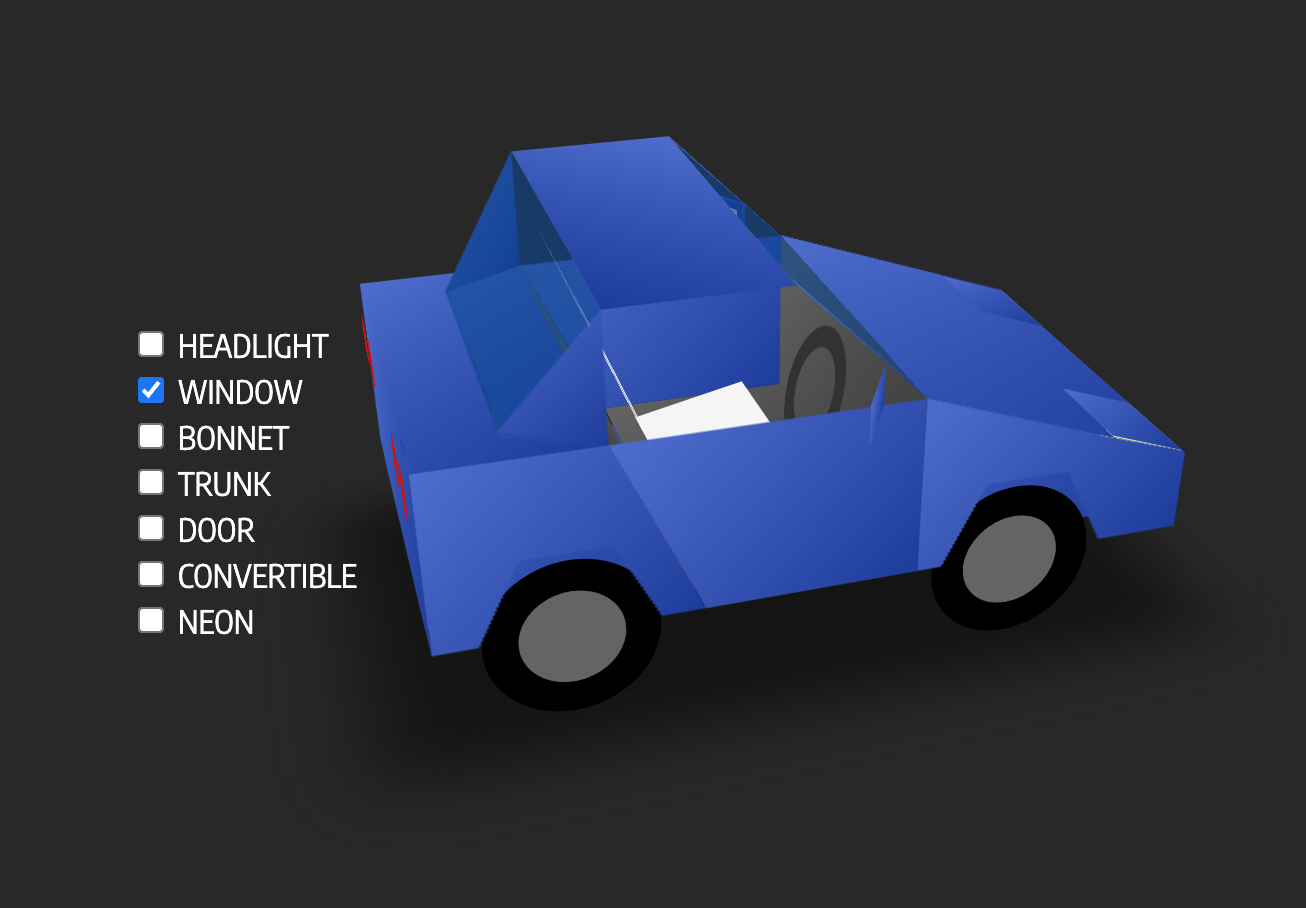
I can’t cover all of the many labs here, but for me, this process was enjoyable for the most part. The labs cover areas of AWS that I haven’t interacted (much) with so far, and they have made me interested in diving deeper. Most of the labs can be completed within about an hour, some more, some less. It depends on which services are being used. Some operations, like training a machine learning model, just take a while, but the time limits on the labs are generous, so I never felt pressured to rush anything.
Here are some of my favorite labs in no particular order:
- Using a Digital Shadow of a Connected Vehicle
- Uses Devices Shadows in IoT to sync interactions between an app and a car
- Connected Vehicles Telemetry
- Build a fully managed streaming data pipeline from IoT to a Grafana Dashboard
- Industrial Personnel and Hazard Tracking
- Deploy an Amplify Webapp to visualize people moving through factories and send an alert when they enter hazardous areas
- Contextualising Industrial Equipment Data
- My first interaction with SiteWise
- Organizing devices into hierarchies (e.g., factories/locations) and visualizing near-real-time metrics
Where there is light, there’s also shadow. In order to complete the game and get the badge, you have to finish all the labs and not all of them work out of the box. Sometimes the instructions are out of date because something in AWS has changed.
Two or three labs require you to sign up for Quicksight, and the UI is entirely different now, which means that some of the steps in the instructions are in the wrong order. This makes it a bit annoying if you’ve never touched Quicksight before.
There’s another lab that asks you to create a CodePipeline v1 through the AWS Console. Unfortunately, only v2 pipelines can be created through the console, and the older ones are no longer supported. Fortunately, all the instructions work pretty much the same way for v2 pipelines, and it’s possible to complete the Lab.
Update: There used to be a more severe issue with another issues that AWS quickly fixed after I reported it, the team moves fast! I’ve removed the outdated section.
Based on these problems, I think AWS should grant you the badge that you receive for completing the game if you finish at least 17 of the 18 challenges; the service teams appear to move faster than the team that’s trying to keep the labs up to date. Once you finish the game, you get this beautiful badge to show off on your social media accounts.
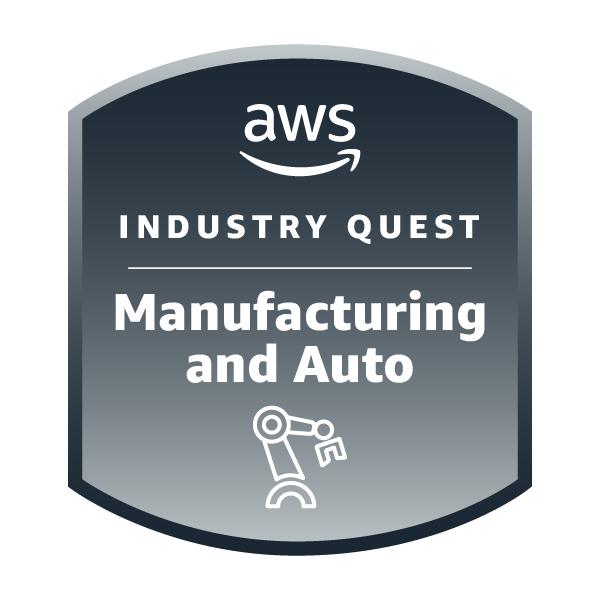
Conclusion
Now that I’ve spent more than 18h on this game, which is the longest I’ve spent on any video game in the last couple of years, it’s time for a conclusion. While there are some hickups with wonky controls and some out of date screenshots I mostly enjoyed myself in these labs.
I liked that the labs were embedded into business problems and encompassed many parts of the AWS ecosystem that I’m not using daily. This means I learned about lots of new services and integration patterns, which will help me make better decisions and recommendations for our customers in the future. If you’re looking for a game to speed-run, this is not it, but if you want to learn something interesting, it’s an excellent place to start.
AWS Skill builder offers many more features and courses than this one. If you’re interested in getting it for your team, we’re able to offer the team subscription for five or more people at a discount. Just get in touch.
— Maurice
